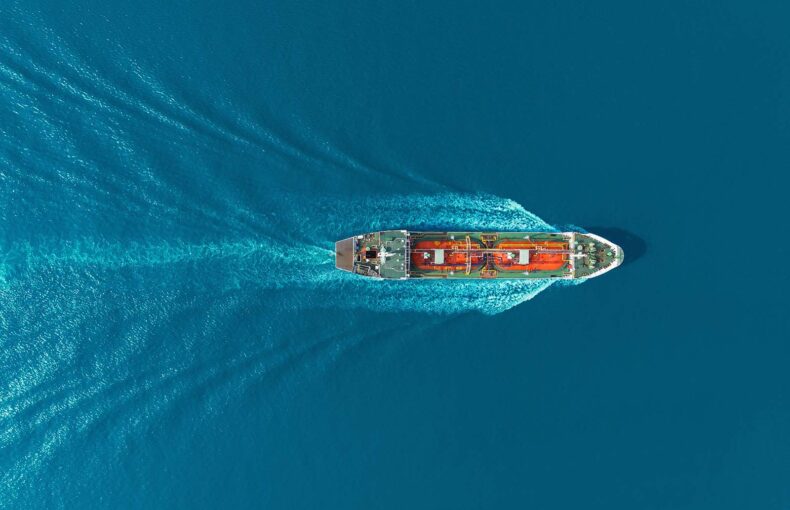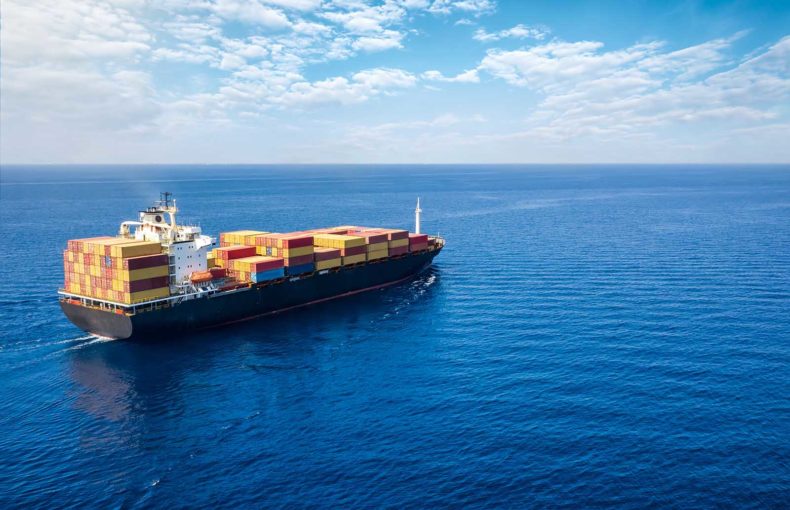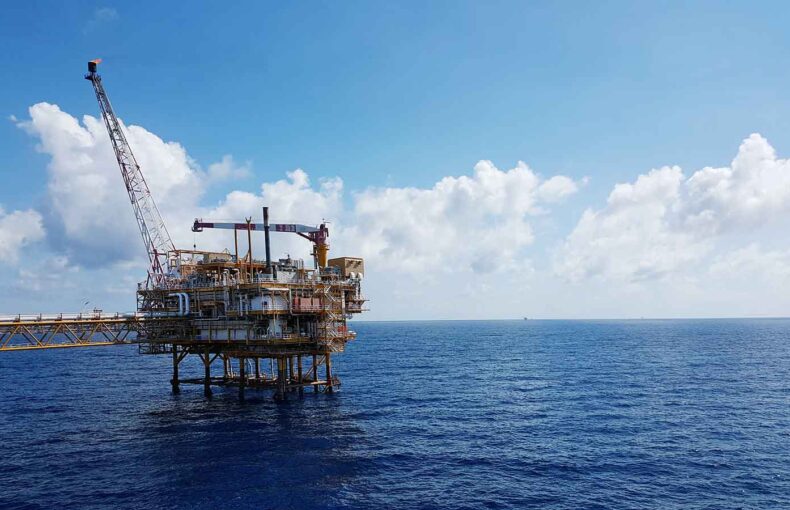Port of Busan: A tech-powered port for a tech forward nation
Like the nation for which it serves as the major port, the Port of Busan has grown dramatically since the end of World War II. After serving as a modest harbor for centuries, it was expanded in the late 1800s to serve as a trade hub with China and Japan, and grew rapidly in the 1960s as South Korea became an export powerhouse. Today, the port is the world’s seventh busiest.
As South Korea transformed from an agrarian nation into an industrial power, the Port of Busan grew at an astounding rate that NASA tracked from orbit. Handling about 80% of South Korea’s container shipments, it sits on the Maritime Silk Road and its host city is the nation’s second-largest.
From ancient site to global economic hub
There is a long history of human settlement and seaborne trade in and around Busan. Located at the mouth of the Nakdong River, the longest river in South Korea, the area has been settled by humans for millennia, with shell mounds dating to the Neolithic period still present in the area. The Bokcheon-dong Burial Mounds in the port area give evidence of a significant political culture during the Three Kingdoms of Korea era (2nd to 4th centuries AD).
The modern port traces its lineage to the early 15th century, by which time there was already informal traffic with Japan, including an expat community. In 1876, the formal port was established as an international transit hub handling trade from both Japan and China.
Jumping ahead to 2004, the current Busan Port Authority (BPA) was established to manage what had become a trade portal of global impact.
A Global Shipping Powerhouse
Today Busan is one of the busiest container ports on Earth, consisting of four sub-ports: North, South, Gamcheon, and Dadaepo. The South and Dadaepo ports handle a significant portion of South Korea’s fishing industry, which consistently ranks in the top 12 in the world, while the North and Gamcheon ports handle containers, passengers, and bulk cargo.
Given it is the largest port of the fifth-ranked global exporter, Busan is vital to the global supply chain and the international consumer market. According to the Observatory of Economic Complexity (OEC), South Korea is among the top producers of integrated circuits (vital to a wide range of products), cars and vehicle parts, refined petroleum, and passenger and cargo ships. Its largest trade partners, none of which have land routes with South Korea, are China, the United States, Vietnam, Hong Kong, and Japan.
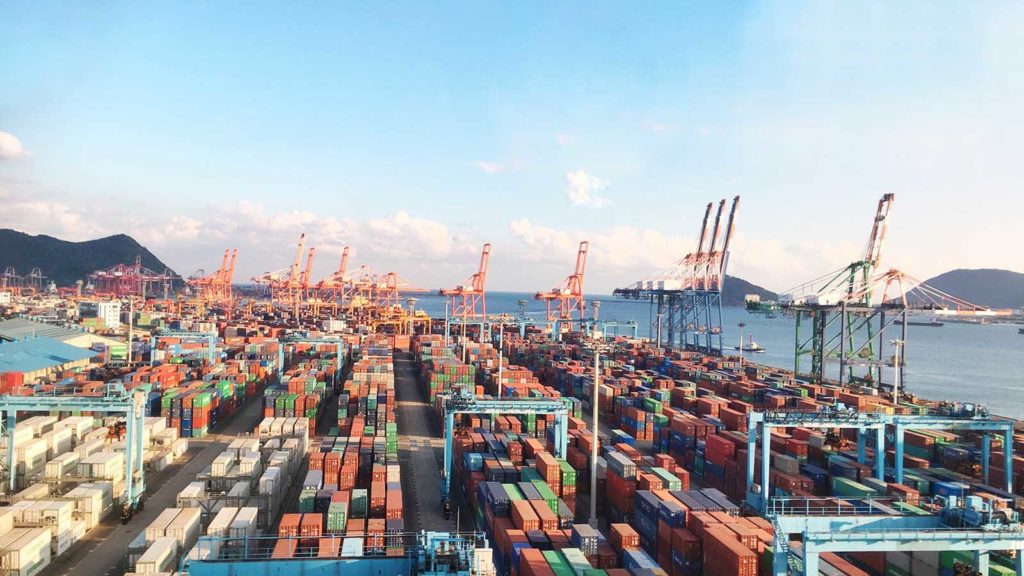
Using Spire’s congestion tool, a snapshot of recent activity at the port shows that over 20 container ships can be arriving per day. It also shows how much port congestion has picked up in 2022, which is troubling given that issues were already pronounced in 2021 due to knock-on effects from China’s port woes.
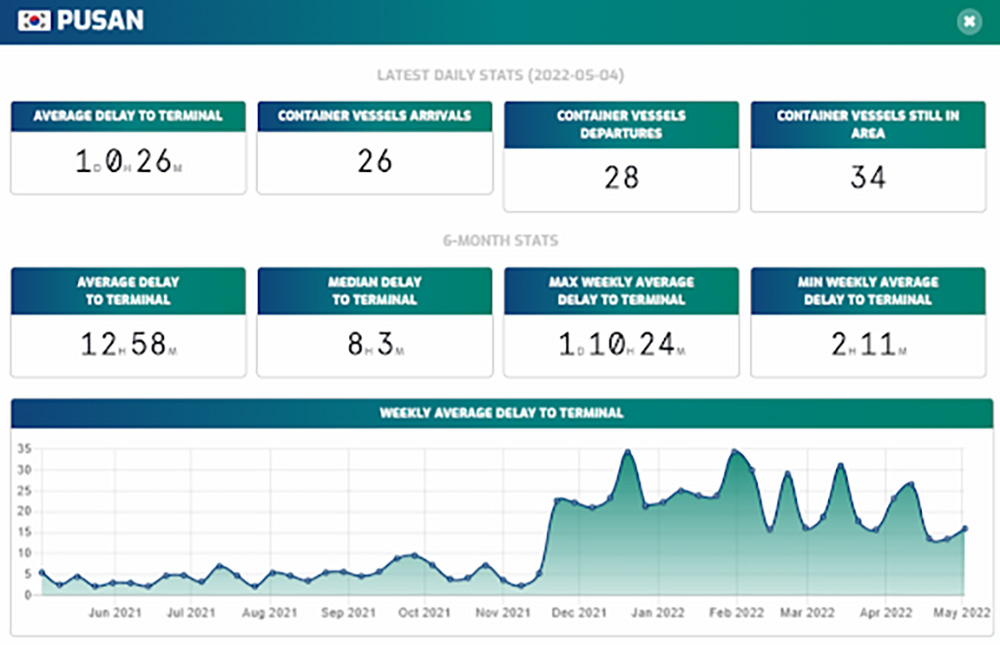
The current issues that started biting in 2021 are not simply about overstretched port functions, though there are ongoing expansion plans to increase capacity, but with problems stemming from the location of containers and carriers prioritizing moving goods out of China.
“Thousands of exporters … are struggling to move their goods through Busan, the world’s 7th busiest container port, where terminals handle over 59,000 containers daily to process about 75% of all shipping for the country,” explained a Reuters piece published in July of 2021. “As global carriers race to deliver everything from furniture to toys to U.S. and European consumers, they prioritize much larger batches of cargo waiting to be picked up along China’s factory belt over Busan. That leaves fewer vessels in the South Korean port and a glut of them in China, cargo managers at Busan’s terminals said.”
This disarray in global shipping, only made worse by the Russian invasion of Ukraine, is another reason why Spire’s Enhanced Satellite AIS is such an indispensable tool for anyone impacted by materials moving through busy ports. With so many challenges—the war, COVID-19 hitting Chinese port operations, container availability —it’s easy for shipment tracking data gaps to develop. Spire’s AIS data feed combines three types of AIS coverage—satellite, terrestrial, and enhanced satellite—delivering more complete and dependable vessel location information, including in and around the world’s busiest ports.
Lightening the Load at Port
With port congestion becoming an increasing problem at Busan, long-range expansion plans are currently in the process of being realized. A new terminal for feeder vessels is under construction.
“It is hoped that the feeder terminal, upon completion in 2025, will reduce logistics costs and therefore, improve the South Korean port’s competitiveness. Busan is Northeast Asia’s container transhipment hub and 50% of its cargoes are from transshipments,” reported Container News in 2021. “A total budget of US$66.05 million has been set aside to build the feeder terminal, which will accommodate ships not exceeding 4,000TEU and will be operated together with the larger berths at the west container pier.”
This comes after the New Port expansion carried out over the past two decades, which has helped Busan keep up with South Korea’s strong export economy.
An innovation-driven port
Given how tech-forward South Korea is, it is not surprising that the Port of Busan is on the cutting-edge of innovation. It’s not only leading the way on a range of pioneering advances for the shipping industry but also the more profound issue of sea-level rise.
The Floating City
One of the most expansive projects on the Port of Busan’s agenda is the recently announced cooperative project spearheaded by UN-Habitat, a United Nations agency focused on urban development, to build OCEANIX Busan as the world’s first prototype floating city. It is a proactive, innovative model project to respond to the rising sea levels driven by global warming.
The partnership is between UN-Habitat, the city of Busan, and the New York-based design firm OCEANIX.
“Today is a pivotal milestone for all coastal cities and island nations on the frontlines of climate change,” stated OCEANIX Chief Executive Officer Philipp Hofmann when announcing the project with the United Nations. “We are on track to delivering OCEANIX Busan and demonstrating that floating infrastructure can create new land for coastal cities looking for sustainable ways to expand onto the ocean, while adapting to sea level rise.”
The project will feature enough infrastructure for 12,000 people to initially call it home, living in mixed-use neighborhoods of between 30,000 to 40,000 square meters that include recreation, art, and performance amenities. There will be three floating platforms with low-rise buildings connected to the coast and the potential to expand to over 20 platforms. The project will include greenhouses and solar power generation that will make OCEANIX Busan energy self-sufficient while six integrated systems—zero-waste and circular systems, closed-loop water systems, food, net-zero energy, innovative mobility, and coastal habitat regeneration—will be the core structure of the project. Water treatment and recycling will also be integral to operations.
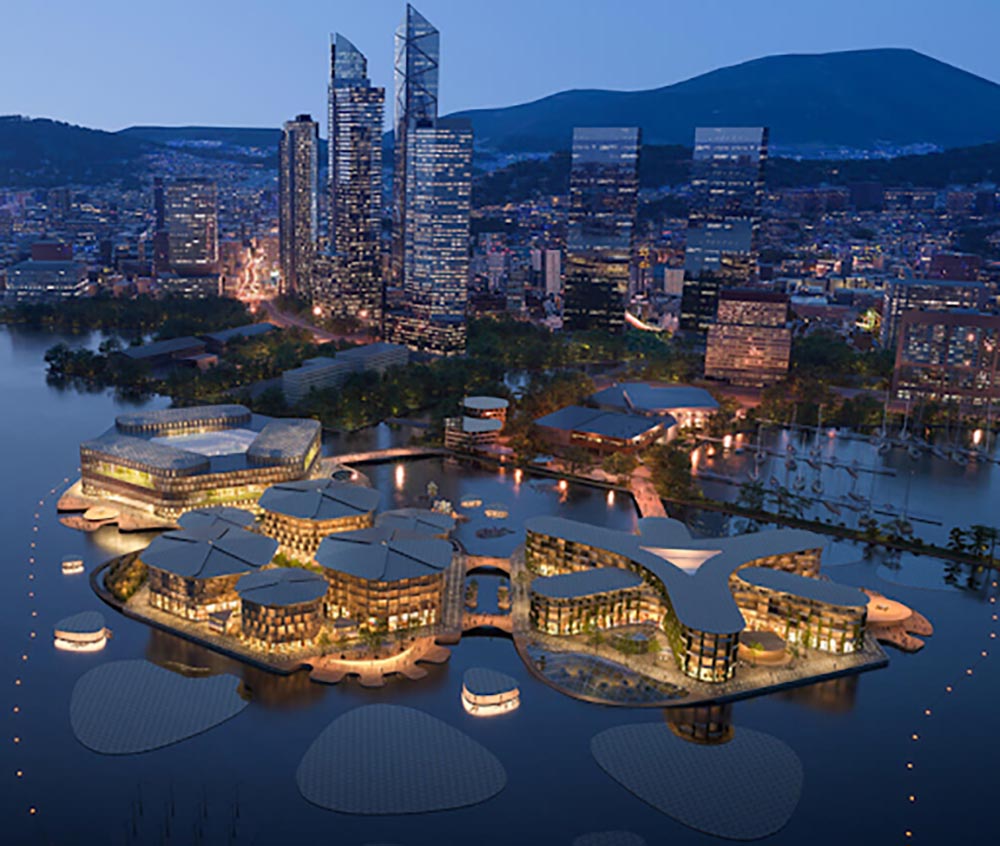
Images courtesy of Oceanix and BIG-Bjarke Ingels Group
“As Mayor of the Metropolitan City of Busan, I take seriously our commitment to the credo ‘The First to the Future,’” stated Mayor Park Heong-joon at the announcement. “We joined forces with UN-Habitat and OCEANIX to be the first to prototype and scale this audacious idea because our common future is at stake in the face of sea-level rise and its devastating impact on coastal cities.”
The announcement of OCEANIX Busan’s development comes on the heels of the recently announced Saudi Arabian plan to build Oxagon, a Red Sea facility that will be a floating port and logistics hub. The twin challenges of rising sea levels and population expansion in coastal areas have to be met with innovative solutions.
“By creating a floating city we limit coastal sprawl, while creating waterfront communities that can be efficiently cooled and controlled using the ocean’s natural moderating effects,” explained the CEO of Oxagon Vishal Wanchoo to Arabian Business. “The floating city will become a landmark attractor for progressive global talent and businesses focused on blue/green economies. These are expected to include sustainable seafood production, biotech development, and synergies in emerging technologies between land-based and marine industries.
Putting Safety at the Forefront
It’s not just “big picture” issues that the Port of Busan is at the forefront of; several forward-looking projects, oftentimes with a focus on greater operational safety, are also part of its development portfolio.
As the CEO of BPA Kang Joon-suk said recently, “BPA will strengthen policy cooperation with the central and local governments and enhance R&D functions to make Busan Port safer and more advanced. We will also do our best to introduce innovative technologies rapidly.”
Container Alignment Safety Monitoring Technology
Harnessing artificial intelligence processes, the port has recently applied for patents on its container-monitoring system. It harnesses CCTV and lidar sensor data, fed into deep-learning programs, to automatically classify the real-time safety status of stacked containers into a Normal (green), Dangerous (yellow), and Very Dangerous (red) classification grid.
Dousing the Danger of Lithium-Ion Batteries
Although lithium-ion batteries are a big component in transitioning from carbon to renewable energy sources, they are not risk-free. The recent catastrophic fire on the Felicity Ace, a roll-on/roll-off cargo ship that sank in the Atlantic in February 2022, was made significantly worse because it was carrying automobiles with lithium-ion batteries. The accident was not a surprise to the professionals responsible for transporting these products, which are known for their innate flammability and hot burning when ignited.
Even before the Felicity Ace accident, the Port of Busan was working with local companies—including Vesta, Busan Techno Park, and Korea Pallet Pool—to design safer shipping containers for handling lithium-ion products.
“Busan processes more than 90 percent of the country’s lithium-ion battery imports and exports, so the development of container technology for safe battery transport is essential,” explained Lee Joon-Seung, the head of Busan’s digital innovation office, to The Loadstar. “By securing safety, the status of Busan as an international port and logistics city will be enhanced.”
IoT Distress Notification System
Last year the port, in cooperation with KT and Sea Bank, began developing a distress notification system using LTE technology. It will include sensors on life jackets that, when they hit the water, will trigger an emergency notification protocol that shares the geo-location of the incident to an emergency network.
Ship it Zero coalition takes notice
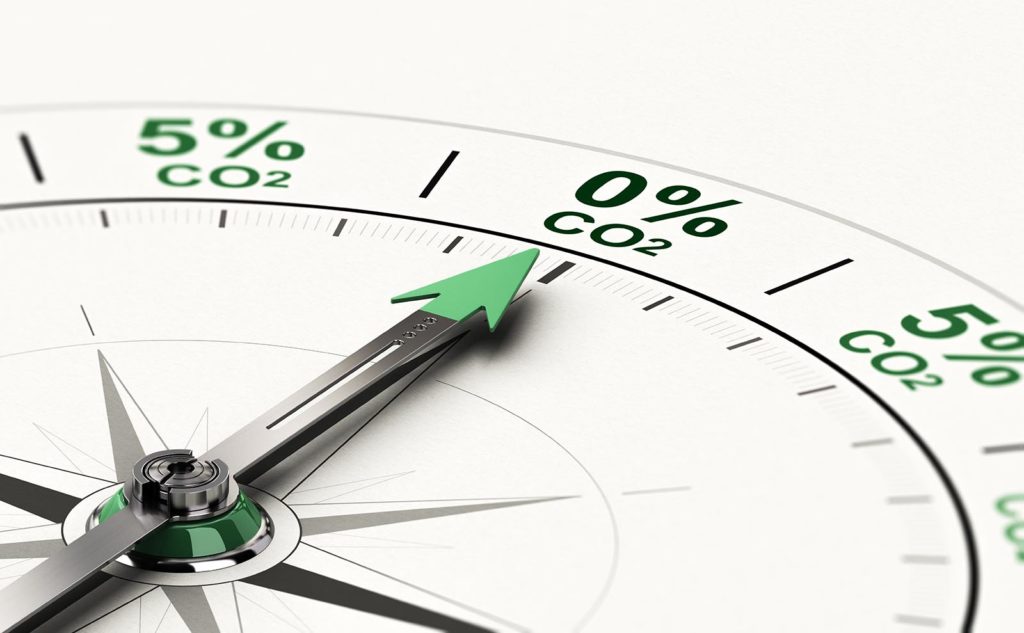 While the shipping industry and ports like Busan adopt new technologies, pressure is building to make ocean transport more environmentally conscious and to lessen its impact on atmospheric warming and the polluting of waterways.
While the shipping industry and ports like Busan adopt new technologies, pressure is building to make ocean transport more environmentally conscious and to lessen its impact on atmospheric warming and the polluting of waterways.
One such effort has put the Port of Busan on notice.
The Ship It Zero coalition is dedicated to pressuring large retail companies to get their ocean-going shipping operations to 100% zero-emission. It includes the environmental organizations Pacific Environment, STAND.earth, and Sort Your Ship Out. Initially focusing on Amazon, IKEA, Target, and Walmart, the immediate goal is to get these companies to zero-emission by 2030.
“Ahead of U.S. President Joe Biden’s visit to Portland and Seattle later this week, climate advocates with the Ship It Zero coalition are calling for the federal government to help address the ocean shipping industry’s growing pollution problem,” the organization announced in an April 20th press release. “Ship It Zero is asking that the administration use funding from the $1 trillion infrastructure package to create a green shipping corridor between Seattle and Busan, South Korea.”
According to a press release released only a week earlier by the US Department of State, “The United States envisions green shipping corridors as maritime routes that showcase low- and zero-emission lifecycle fuels and technologies with the ambition to achieve zero greenhouse gas emissions across all aspects of the corridor in support of sector-wide decarbonization no later than 2050.”
Given the technological savvy of South Korea, it would be hard to imagine a more suitable foreign partner for US ports to work with in creating green shipping corridors.
What lies ahead?
Humans have lived in the Busan area for eons. Given the forward-thinking management of today’s port, even while facing the challenges of climate change and supply chain challenges, it will likely continue to be one of the most important and innovative transportation hubs in the world.
The OCEANIX project is an especially potent effort to harness technology to build new and less-damaging ways of being. Along with embracing green shipping strategies and the judicious use of new tech solutions, the Port of Busan will be at the forefront of change in the coming decades.
 Written by
Written by
